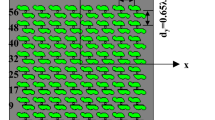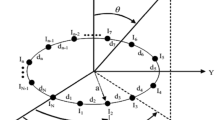Abstract
In this paper, authors propose a method based on the modified particle swarm optimization (PSO) for beam reconfiguration of linear array of mutually coupled parallel half-wavelength dipole antennas with real excitation voltage amplitude distribution. Two different beam pairs are generated, one pencil/pencil beam pair and another pencil/flat-top beam pair in the horizontal plane. One beam is changed to another through switching while sharing a common amplitude distribution. Two examples are presented, one without ground plane and another in presence of ground plane. Dipoles are connected to its feed network through a switch, so that it can be turned on or off, depending on the switch position. Beam reconfiguration is achieved by suitably turning the array elements on or off using same voltage excitation distribution. Modified PSO is used to compute the excitation voltages as well as the switching configuration for each pattern having a prefixed side lobe level. The current in the driven and parasitic elements is determined via induced EMF method considering the current distribution on each dipole to be sinusoidal. Proposed method efficiently synthesizes dual-beam switching the power pattern from pencil to pencil and pencil to flat-top having same or different side lobe levels using common excitation voltages. It calculates the maximum variation of the active impedance of driven elements and the power losses when the radiation patterns switch from one beam to another. The paper calculates the array directivity as the distances between antenna array and the ground pane varies. Three other state-of-the-art metaheuristics like differential evolution, gravitational search algorithm, artificial bee colony algorithm are also employed for achieving a comparative evaluation.









Similar content being viewed by others
References
Bucci OM, Mazzarella G, Panariello G (1991) Reconfigurable arrays by phase-only control. IEEE Trans Antennas Propagat 39(7):919–925
Durr M, Trastoy A, Ares F (2000) Multiple pattern linear antenna arrays with single prefixed amplitude distributions modified Woodward-Lawson synthesis. Electron Lett 36(16):1345–1346
Diaz X, Rodriguez JA, Ares F, Moreno E (2000) Design of phase-differentiated multiple-pattern antenna arrays. Microw Opt Technol Lett 16(1):52–53
Bregains JC, Trastoy A, Ares F, Moreno E (2002) Synthesis of multiple-pattern planar antenna arrays with single prefixed or jointly optimized amplitude distributions. Microw Opt Technol Lett 32(1):74–78
Trastoy A, Rahmat-Samii Y, Ares F, Moreno E (2004) “Two pattern linear array antenna: synthesis and analysis of tolerance”. IEE Proc Microw Antennas Propagat 151(2):127–130
Mahanti GK, Chakraborty A, Das S (2007) Design of fully digital controlled reconfigurable array antennas with fixed dynamic range ratio. J Electromagn Waves Appl 21(1):97–106
Akdagli A, Guney K, Babayigit B (2007) Clonal selection algorithm for design of reconfigurable antenna array with discrete phase shifters. J Electromagn Waves Appl 21(2):215–227
Vaitheeswaran SM (2008) Dual beam synthesis using element position perturbations and the G3-GA algorithm. Progress In Electromagn Res PIER 87:43–61
Rodríguez JA, Trastoy A, Brégains Julio C, Ares F, Franceschetti G (2006) “Beam reconfiguration of linear arrays by using parasitic elements,”. Electron Lett 52(3):131–133
Yuan HW, Gong SX, Zhang PF, Wang X (2008) Wide scanning phased array antenna using printed dipole antennas with parasitic element. Progress In Electromagn Res Lett 2:187–193
Álvarez-Folgueiras M, Rodríguez-González JA, Ares-Pena F (2009) “Low-Sidelobe Patterns From Small, Low-Loss Uniformly Fed Linear Arrays Illuminating Parasitic Dipoles,”IEEE Trans on Antennas and Propagat Vol 57, No. 5
Quevedo-Teruel Ó, Rajo-Iglesias E (2006) Ant colony optimization in thinned array synthesis with minimum sidelobe level. IEEE Antennas Wireless Propagat Lett 5:349–352
Mahanti GK, Pathak N, Mahanti P (2007) Synthesis of thinned linear antenna arrays with fixed sidelobe level using real-coded genetic algorithm. Progress In Electromagn Res PIER 75:319–328
Haupt RL (1994) Thinned arrays using genetic algorithms. IEEE Trans Antennas Propag 42(7):993–999
Kennedy J, Eberhart RC (1995) “Particle swarm optimization,” in Proc IEEE Int Conf Neural Networks pp 1942–1948
Li WT, Shi XW, Hei YQ (2008) An improved particle swarm optimization algorithm for pattern synthesis of phased arrays. Progress In Electromagn Res PIER 82:319–332
Jin N, Rahmat-Samii Y (2007) Advances in particle swarm optimization for antenna designs: real-number, binary, single- objective and multiobjective implementations. IEEE Trans Antennas Propag 55(3):556–567
Chen TB, Dong YL, Jiao YC, Zhang FS (2006) Synthesis of circular antenna array using crossed particle swarm optimization algorithm. J Electromagn Waves Appl 20(13):1785–1795
Razavi A, Forooraghi K (2008) Thinned arrays using pattern search algorithms. Progress In Electromagn Res PIER 78:61–71
Bucci OM, Isernia T, Morabito AF (2010) A deterministic approach to the synthesis of pencil beams through planar thinned arrays. Progress In Electromagn Res PIER 101:217–230
Ares F, Franceschetti G, Rodriguez JA (2008) A simple alternative for beam reconfiguration of array antennas. Progress In Electromagn Res PIER 88:227–240
Wang LL, Fang DG, Sheng WX (2003) Combination of genetic algorithm (GA) and Fast Fourier transform (FFT) for synthesis of arrays. Microw Opt Technol Lett 37(1):56–59
Pathak N, Basu B, Mahanti GK (2011) Combination of inverse Fast Fourier transform and modified particle swarm optimization for synthesis of thinned mutually coupled linear array of parallel half-wave length dipoles antennas. Progress In Electromagn Res M 16:105–115
Elliott RS (2003) Antenna theory and design. John Wiley and Sons, Inc., Hoboken, Revised edition
Hansen RC (1972) Formulation of echelon dipole mutual impedance for computer. IEEE Trans Antennas Propagat 6:780–781
Das S, Abraham A, Chakraborty UK, Konar A (2009) Differential evolution using a neighborhood-based mutation operator. IEEE Trans Evolutionary Comput 13:526–553
Chatterjee A, Mahanti GK, Pathak NN (2010) Comparative performance of gravitational search algorithm and modified particle swarm optimization algorithm for synthesis of thinned scanned concentric ring array antenna. Progress In Electromagn Res B 25:331–348
Basu B, Mahanti GK (2011) Fire fly and artificial bees colony algorithm for synthesis of scanned and broadside linear array antenna. Progress In Electromagn Res B 32:169–190
Mahanti GK, Das S, Chakraborty A (2006) “Design of Reconfigurable Array Antennas with Minimum Variation of Active Impedances”, IEEE Antennas Wireless Propagat Lett vol 5
Author information
Authors and Affiliations
Corresponding author
Rights and permissions
About this article
Cite this article
Basu, B., Mahanti, G.K. Beam reconfiguration of linear array of parallel dipole antennas through switching with real excitation voltage distribution. Ann. Telecommun. 67, 285–293 (2012). https://doi.org/10.1007/s12243-011-0273-8
Received:
Accepted:
Published:
Issue Date:
DOI: https://doi.org/10.1007/s12243-011-0273-8




